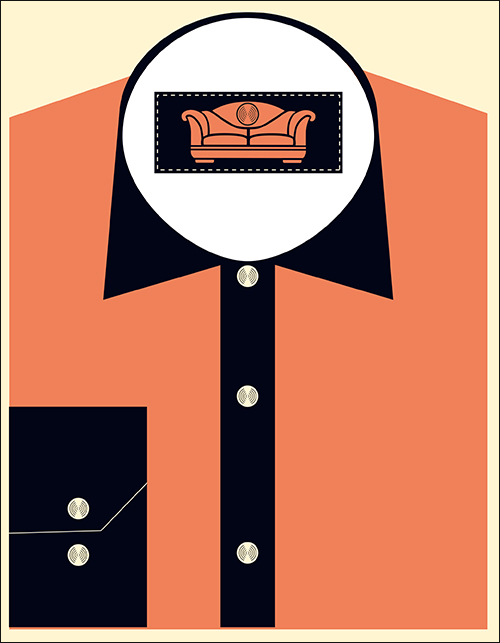Anyone following the radio frequency identification industry is likely aware that major retailers in Europe, North America and South America are embracing the technology to track and manage apparel and footwear, to improve inventory accuracy and provide customers with an omnichannel anytime, anywhere shopping experience. “Apparel is a proven use case” for ultrahigh-frequency RFID, says Bill Hardgrave, dean of Auburn University’s Harbert College of Business, founder of the RFID Research Center and a retail columnist for RFID Journal magazine. “We’ve done apparel long enough to know where the benefits are, and it’s a relatively easy product to tag—it’s RF-friendly and not onerous to figure out where to put the tag.”
Less well known is the fact that department and specialty retailers are turning to RFID to manage nonapparel items—from cosmetics to furniture and sporting goods—and the benefits in these categories could prove more substantial. Hardgrave cites cosmetics, for example, as a very high-shrink item, much more so than many products in the apparel category. In fact, black mascara is the biggest headache, says a VP of loss prevention at a major drugstore chain, who has discussed Checkpoint Systems‘ merchandise availability solutions with Su Doyle, head of that vendor’s RFID industry programs. “It’s a top 10 high-theft item in stores—small, easy to conceal and easy to resell on the gray market,” Doyle says.
Some retailers have conducted pilots to track health and beauty items, as well as ink cartridges and other office supplies. And more are considering it, Hardgrave says. “We have talked about some of those categories with retailers, and we will see retailers outside of what you may think of as apparel doing some interesting things with RFID,” he says. “And once one or two larger retailers go, others will take notice and follow.”
In another sector, sporting goods retailers that first began using RFID to manage seasonal items such as ski jackets and bathing suits—in which the need to keep the right assortment of products in stock for winter, spring, summer or fall activities is critical—are extending that mindset to sports equipment, because seasonality also drives inventory, Doyle says. Mammoth Outdoor Sports, in California, uses RFID technology to merge its Internet and retail store inventories, and to get a daily report showing which products are at its warehouse and stores or at exhibitions. Decathlon, a French sporting goods manufacturer and retailer with 700 stores in 18 countries, has also jumped on the RFID bandwagon.
Department stores that have had success RFID-tracking select apparel items now want to extend their deployments to more apparel categories—and to other merchandise. “Some leading department stores want to get to 100 percent of their store inventory being tagged in the next few years,” says Melanie Nuce, VP of apparel and general merchandise at global supply chain standards organization GS1 US.
Target, for example, announced earlier this year that it is adopting a companywide RFID item-level tagging program, to improve its inventory accuracy and enhance its ability to keep stores well stocked. The retailer has begun RFID-tagging select products— specifically, men’s basics and women’s denim and swimwear—at stores in the Minneapolis area, according to a Target spokesperson.
Beginning in the first quarter of 2016, Target plans to take the technology chainwide and expand it to include all women’s ready-to-wear apparel, kids and baby apparel, and athletic wear—and soft home goods such as towels, linens and pillows. (The company has plans for additional category rollouts but doesn’t have details to share yet.) “We’re starting with these areas because guests love our style offerings, and because they are popular order pickup items [buy-online-pickup-in-store],” the spokesperson says.
U.K. retailer Marks & Spencer announced in May that it is expanding its use of RFID technology at most of its stores, from 80 percent of its general merchandise toward a goal of tagging 100 percent of goods within the next two years. The retailer sells everything from clothing to food, home goods and furniture. By next spring, M&S plans to tag the remainder of its homeware merchandise—including kitchenware, children’s books and stuffed toys—and by the end of 2016, it aims to tag most beauty and cosmetics products.
The Retail Business Case
As in apparel retail, improving inventory accuracy is the foundation for many retail deployments. Building on that, and depending on the category, RFID can help solve other business problems. Shrink, for example, is a multibillion dollar problem for retailers globally. For some retailers and malls, the technology is helping to enhance the shopping experience.
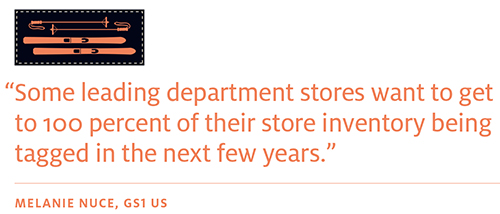
Cosmetics is a high-profit but hard-to-inventory item for department stores, Doyle says. Checkpoint, she adds, is involved in active pilots to track beauty products with RFID for retailers in North America and Europe, though it’s too early to name the stores or cosmetics companies.
The data collected from RFID-tagged cosmetics items can expose theft patterns—when, for example, these products leave stores without being paid for, perhaps during a particular employee’s work shift. With this information, retailers can take action to prevent loss. In addition, cosmetics are the kind of products that demand a store have what the consumer wants when she or he wants it. A shopper may be persuaded to buy her favorite style of jeans in a lighter or darker color, but the store is likely to miss a sale if it doesn’t have her go-to lipstick or eye shadow.
In a drugstore or specialty health-and-beauty retail shop, many different lipsticks and other small cosmetics items are often displayed on pegboards, and it’s easy for a stockperson to mistakenly load specific color slots with identically packaged items of similar colors. Store associates may assume a popular lipstick is well represented on the sales floor when it’s actually running low. “The consumer comes in, thinks the store doesn’t have their shade of red, and it becomes a lost sale,” Hardgrave says.
Tag these items, Doyle says, and the retailer “has a way to keep complex cosmetic SKUs in stock in densely packed merchandising displays.” It also enables sales associates to help customers quickly find the exact item they want among so many look-alike containers, each with a wide variety of colors and shades.
For Target and many other retailers, RFID is key to providing an omnichannel shopping experience. Without the inventory accuracy RFID data can provide, retailers build in a buffer, Hardgrave says. They might, for example, have a business rule that says: If inventory at the store shows fewer than three items in stock, show it online as out of stock. “They don’t want to send you to the store and, when you get there, for it not to be there,” Hardgrave says. “They conceal their inventory from the consumer.” In the process, the retailer puts itself in the position of losing the sale to a competitor. “That’s why we will see retailers—and the electronics sector is a great business case for this—forced to use RFID to really provide the omnichannel experience the consumer demands,” he says.
“The use of buy-online-and-pickup-in-stores is huge,” Hardgrave says, noting that electronics is one area in which it’s really hitting home. Consumers want to research these products, especially higher-priced items, on the Web, buy them online, and still have the instant gratification of going to the store and getting them right away.
Retailers of all types of items are eager to raise their game against the mighty Amazon, which can deliver items in a day or even less. In addition, Doyle says, “studies show that if someone comes in to a store to pick up an order, he or she is 40 percent to 45 percent more likely to buy other items as well.”
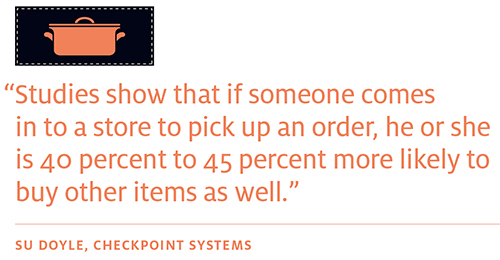
Overcoming RFID Obstacles
Cost is no longer a significant concern when it comes to RFID-tagging items. Retailers are tagging socks, undergarments and other relatively low-margin items, Hardgrave points out, so cost shouldn’t be prohibitive on products with healthy price points, such as electronics and sporting goods. “Cost only comes in when there’s not a benefit,” he says, and clearly there is a benefit with RFID.
But tagging pots and pans and other nonapparel items presents some challenges. M&S, for example, worked closely with Avery Dennison Retail Branding and Information Solutions to design EPC Gen 2 RFID tags in different sizes and shapes to accommodate a wide range of merchandise, including items containing non-RF-friendly metal or liquids. They developed 10 tag formats and 70 tag variations, and accounted for cosmetics and other manufacturers’ aesthetic requirements in the designs.
Checkpoint also has been working to address some of the unique tagging challenges for hard goods, Doyle says. Both its Slim and Whisper RFID labels for cosmetics categories come in very small form factors so they can be placed on tiny cases without obscuring the packaging and can be read at very short distances (as likely would be necessary for scanning products on pegboards). The Slim label can also be strategically placed over the edges of a box to make the box tamperproof.
It’s critical to consider “what makes the tag readable and the product merchandisable,” GS1’s Nuce says. Tag placement can also be a concern when it comes to jewelry, as metal content makes it difficult to put a tag right up against the item but merchandising requirements typically dictate avoiding any type of trim (RFID tag, price tag or label of any sort) that would detract from product aesthetics. “The functional challenge with any technology deployment is how to satisfy all users,” she says.
As retailers expand RFID into new product categories, they’ll have to convince another tier of suppliers to tag items at the source. Target, for example, will work closely with its vendor partners as it rolls out RFID usage across categories, the spokesperson says.
“We’re asking that RFID tags be applied to items at the vendor/product manufacturer level,” he says. “Most apparel vendors today order a tag to attach to products; with RFID, they will simply order an RFID-enabled tag.” Hardgrave doesn’t think that will present too many concerns, though suppliers will likely want to know what reimbursements they might expect for incurring additional costs or what benefit they’ll get. “Will the retailer share information with them to help them be a better partner, which results in better sales?” he says. “Those are universal conversations regardless of whether you are doing T-shirts or big-screen TVs.”
Retailers also have a wide choice of RFID readers, including handhelds, fixed overhead and portal readers, and robotic systems. Today, brick-and-mortar stores are doing a lot of remodeling to provide customers with an engaging physical experience—something online retailers can’t do, Doyle says. They want to make their environments more welcome and their stores more modern. “And if you’re going to make a store look more modern, you might as well modernize the infrastructure to match,” she says. “It’s interesting how much store design is driving some of the investment in sensor technologies like RFID today.”
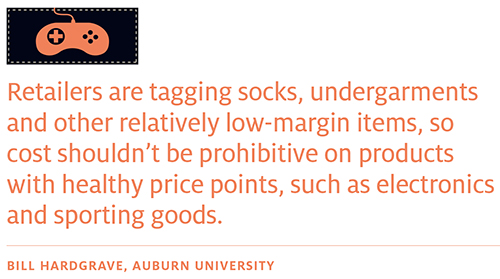
So what’s in store for department and specialty retailers? Some nonapparel retailers are piloting and deploying RFID, and GS1 US expects adoption to continue next year, Nuce says. Hardgrave goes even further: “I expect some announcements of nonapparel categories from some retailers and a few nonapparel retailers.”
Are Brick-and-Mortar Retailers Going the Way of Dinosaurs? Not So Fast!
Americans plan to do almost half of their holiday shopping online this year, according to the National Retail Federation‘s Holiday Consumer Spending Survey, conducted in October. As brick-and-mortar retailers vie for consumers’ attention, they are turning to RFID technologies to enhance the shopping experience.
Video game retailer GameStop, for example, has been trialing a Bluetooth Low Energy (BLE) beacon-based system at 36 stores in Austin, Texas, to engage real-world customers. Shoppers can hold their smartphones up to beacons to learn more about the products on display in a particular area, receive promotional discounts, read reviews and ratings, and view video game trailers. GameStop’s long-term goal is to set up a technology-based engagement system throughout all stores, says Charlie Larkin, senior director of technology innovation. It may incorporate Near-Field Communication and other technologies, he says, so consumers can access data by tapping their smartphones near passive NFC RFID tags.
Last September, U.S. retail real-estate developer Simon began deploying a BLE beacon system at nearly 240 malls and shopping centers, to help merchants connect with their customers based on real-time data regarding each shopper’s location at those sites. According to Business Insider‘s BI Intelligence research and information service, beacons are expected to directly influence more than $4 billion worth of U.S. retail sales this year, and in 2016 the number will climb tenfold.
Appliance, car, furniture and other retailers that display big-ticket items in showrooms are also considering or deploying NFC and BLE beacon technology, to provide customers with the information they could access if they were shopping online. Before making a big purchase, consumers want to know: What other colors or materials does the product come in, and how do they look? Has the item been favorably reviewed by other buyers? What are the retailer’s shipping, return and warranty policies?
Made.com, which began as an online furniture retailer, now has three showrooms in the United Kingdom. To remain relevant in the age of e-commerce and to differentiate itself from traditional furniture retailers, Made.com is using CloudTags technology at all three stores, says Rebecca Ruddle, head of showrooms.
CloudTags‘ solution includes NFC RFID tags to attach to showroom items, BLE beacons and location-aware tablets for shoppers. “We prepackage everything to make it an exceptionally easy experience,” says CloudTags CEO James Yancey. “Unless shoppers are completely loyal to a store and go there all the time, they mostly don’t want to download their apps, and often they don’t have enough technical knowledge to turn BLE or NFC on.”
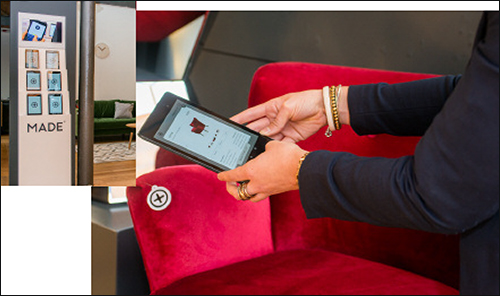
When a customer uses a retailer-provided tablet to tap on or near an item’s NFC tag or comes within a couple of inches of it, content about the product—name, cost, available colors and so on—is sent from the retailer’s system to the device. “The beacons are great so we know where the customer is standing and for how long, and we can show supportive messages about what they are interacting with,” Yancey says. If, for instance, they remain in front of a sofa in a furniture showroom for 60 seconds, a window on the tablet can pop up showing top customer reviews about the item from the retailer’s website, or an offer for 15 percent off shipping.
Made.com reports that the technology has had a considerable impact on sales—the average order value of customers who use the tablets is roughly 25 percent greater than those who don’t. That’s due largely to “the lovely e-mail they get after using the tablet showing items they tagged in the store that they can buy with two clicks on our website,” Ruddle says. Customers can remain anonymous while exploring, or share their name and e-mail address with the retailer. The e-mails, Ruddle explains, help shoppers who were focused on the main purchase at the time—a sofa, for instance—recall that they also liked the rug that was paired with it in the showroom setting. The e-mail keeps them from forgetting those nice add-ons that increase order value, she says.
The CloudTags solution also frees up sales associates to help shoppers who aren’t using the tablets. But, Ruddle says, shoppers like to use the tablets. When Made.com first trialed the solution at its Notting Hill, London, showroom, roughly a year and a half ago, approximately 15 percent of customers used the tablets. Today, customer usage at the showrooms is 42 percent.
If a customer buys a product online 15 to 30 days after opening a follow-up e-mail, most CloudTags clients give full or partial credit for the website purchase to the associate who helped the customer, Yancey says. That helps address a salesperson’s worst nightmare—the in-store customer who says he or she isn’t ready to make a decision after an associate spends a lot of time trying to close a deal. Getting this all to work well is “not as simple as just throwing beacons and tablets in the store,” he points out. “You’ve got to figure out some way that everyone feels they are winning.”
There are other business benefits, Ruddle says. By capturing customers’ e-mail addresses on the tablets, Made.com can attribute online sales to each showroom. And, she says, during her quarterly review of items on display in each showroom, it’s very easy to make decisions about what to move in and out of the showrooms. “We get a top 10 list of each showroom’s items and postcards that people tap, and we can refer to that to make informed decisions of each item we have on display,” she explains.
Made.com is readying a trial with the tablets and beacons that could further impact revenue. It enables shoppers to view a sofa, chair or other item they’re considering in a real-life buyer’s home on their tablet. The application uses the company’s Made Unboxed social platform, which enables customers to post pictures of their interiors featuring Made.com products and view others’ designs for inspiration. “We’ll see what the engagement rate is,” Ruddle says, “and whether we can leverage this to really transform the experiences customers have in retail spaces.”

